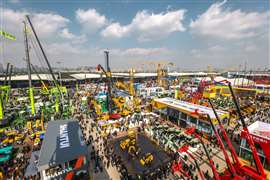Friday roundup: smarter and safer transport; China’s new towers; defying the slowdown; Tadano promises surprises
10 January 2025
 Bauma China 2024. Photo: Bauma
Bauma China 2024. Photo: Bauma
We started the first week of 2025’s Crane and Transport Briefings (CTB) with a look at how the specialized transport industry is stepping up with smarter, safer, and more efficient solutions for moving massive equipment and structures.
At the heart of this innovation is self propelled modular transporter (SPMT), which has become the gold standard for hauling supersized loads like wind turbine components, industrial reactors, and bridges.
From cutting-edge telematics for real-time diagnostics to modular designs that tackle extreme climates and challenging terrain, SPMT is evolving to meet growing demands.
Crane and Transport Briefing’s Niamh Marriott examines how industry leaders are driving these advances and rounds up recent groundbreaking specialized transport projects such as Geneva Airport’s runway renewal, France’s new offshore wind farms, and the installation of Europe’s largest wooden pedestrian bridge.
Bauma towers
Next, we looked at the new tower cranes from the Bauma China 2024 trade show held in late November. There was a strong showing of new tower cranes, especially from many of the large number of domestic manufacturers.
This crane type was a strong element of the event in spite or perhaps because of the deep recession in residential construction in China. One domestic manufacturer told International Cranes and Specialized Transport (ICST) sales were down 40 per cent, with the company held afloat only by exports to Russia.
Manufacturers Dahan, Elmak (from Turkey) Huba, Jinnta, Topsky, XCMG and Zoomlion were all present. Liugong which acquired a tower crane manufacturer three years ago was exhibiting them under the Join Hands brand. Yongmao also had a presence as did Liebherr and Manitowoc.
Mid-range flat tops were prevalent, followed by luffing jib models, some of which were hydraulic. Several new big flat tops in the 80 to 100 tonne range were also presented.
Having said that about the domestic market, there are signs things are picking up, at least at the heavy end. For power plant construction cranes of 64 tonnes and upwards, both flat top and luffing jib types, are now needed, one manufacturer told ICST.
Staying strong
On Wednesday we reported how the construction industry in North America has experienced a whirlwind of activity in recent years, fuelled by pandemic-driven housing demand, transformative legislation like the CHIPS Act and sustained infrastructure investments under the IIJA and IRA.
While many equipment markets have normalised after the boom years, the mobile crane sector continues to defy expectations with remarkable growth in 2024. Specialist forecaster Off-Highway Research (OHR) projects a 7 per cent increase in mobile crane sales for the year, even as other segments like compact earthmoving machines face declines.
What’s driving this trend? From recovering supply chains to the unique resilience of infrastructure and non-residential construction, mobile cranes have proven indispensable to the evolving demands of the construction landscape. Dive into the data and uncover the factors shaping the industry as OHR’s Chris Sleight reflects on last year’s market.
Look out for surprises
As an example of the above Thursday’s CTB was an interview with the president and CEO of Tadano pan-America, Dean Barley. He travels the world making new relationships, strengthening old relationships and above all, selling cranes. He’s also involved in product development, manufacturing processes and strategic planning, to name a few.
His division has been putting up some impressive numbers over the past couple of years. Crane sales numbers were through the roof from 2022 to 2023, with his team notching a 57 percent growth in North American business. Even during a presidential election year with economic uncertainty looming, the division’s third quarter of 2024 grew 19 percent over 2023.
“The biggest market is the United States closely followed by Canada and then Latin America,” Barley said. “Leading up to the election, everyone was in a wait-and-see mode. Although we have a feeling where the market will go in 2025, only time will tell.”
Last summer, ACT Editor D.Ann Shiffler travelled to Japan with Barley to see three Tadano facilities and visit the company’s corporate offices in Tokyo. They made a plan to have a year-end interview to discuss all things Tadano.




